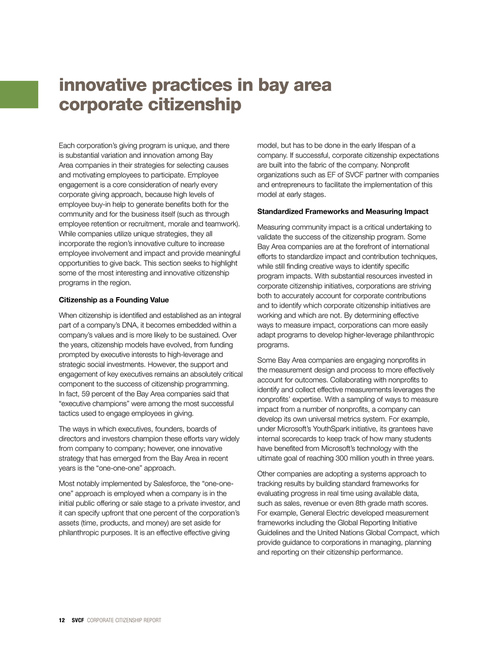
innovative practices in bay area corporate citizenship
Each corporation’s giving program is unique, and there is substantial variation and innovation among Bay Area companies in their strategies for selecting causes and motivating employees to participate. Employee engagement is a core consideration of nearly every corporate giving approach, because high levels of employee buy-in help to generate benefits both for the community and for the business itself (such as through employee retention or recruitment, morale and teamwork). While companies utilize unique strategies, they all incorporate the region’s innovative culture to increase employee involvement and impact and provide meaningful opportunities to give back. This section seeks to highlight some of the most interesting and innovative citizenship programs in the region. Citizenship as a Founding Value When citizenship is identified and established as an integral part of a company’s DNA, it becomes embedded within a company’s values and is more likely to be sustained. Over the years, citizenship models have evolved, from funding prompted by executive interests to high-leverage and strategic social investments. However, the support and engagement of key executives remains an absolutely critical component to the success of citizenship programming. In fact, 59 percent of the Bay Area companies said that “executive champions” were among the most successful tactics used to engage employees in giving. The ways in which executives, founders, boards of directors and investors champion these efforts vary widely from company to company; however, one innovative strategy that has emerged from the Bay Area in recent years is the “one-one-one” approach. Most notably implemented by Salesforce, the “one-oneone” approach is employed when a company is in the initial public offering or sale stage to a private investor, and it can specify upfront that one percent of the corporation’s assets (time, products, and money) are set aside for philanthropic purposes. It is an effective effective giving model, but has to be done in the early lifespan of a company. If successful, corporate citizenship expectations are built into the fabric of the company. Nonprofit organizations such as EF of SVCF partner with companies and entrepreneurs to facilitate the implementation of this model at early stages. Standardized Frameworks and Measuring Impact Measuring community impact is a critical undertaking to validate the success of the citizenship program. Some Bay Area companies are at the forefront of international efforts to standardize impact and contribution techniques, while still finding creative ways to identify specific program impacts. With substantial resources invested in corporate citizenship initiatives, corporations are striving both to accurately account for corporate contributions and to identify which corporate citizenship initiatives are working and which are not. By determining effective ways to measure impact, corporations can more easily adapt programs to develop higher-leverage philanthropic programs. Some Bay Area companies are engaging nonprofits in the measurement design and process to more effectively account for outcomes. Collaborating with nonprofits to identify and collect effective measurements leverages the nonprofits’ expertise. With a sampling of ways to measure impact from a number of nonprofits, a company can develop its own universal metrics system. For example, under Microsoft’s YouthSpark initiative, its grantees have internal scorecards to keep track of how many students have benefited from Microsoft’s technology with the ultimate goal of reaching 300 million youth in three years. Other companies are adopting a systems approach to tracking results by building standard frameworks for evaluating progress in real time using available data, such as sales, revenue or even 8th grade math scores. For example, General Electric developed measurement frameworks including the Global Reporting Initiative Guidelines and the United Nations Global Compact, which provide guidance to corporations in managing, planning and reporting on their citizenship performance.
“the support and engagement of key executives remains an absolutely critical component to the success of citizenship programming. In fact, 59 percent of the Bay Area companies said that ‘executive champions’ were among the most successful tactics used to engage employees in giving.”
Successful Tactics for Engaging Employees in Giving
12
SVCF CORPORATE CITIZENSHIP REPORT
SVCF CORPORATE CITIZENSHIP REPORT
13